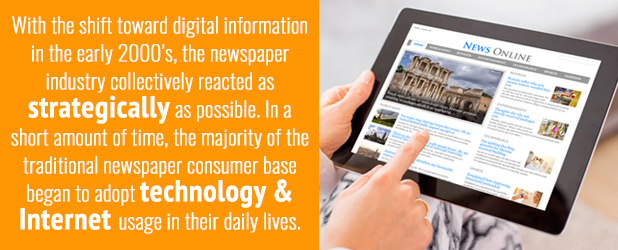The information revolution brought about an enormous amount of change in social conduct. With access to seemingly endless streams of information online, consumer behavior shifted, and demands grew to become much more instant-access oriented.
With these consumer and technology-driven marketplace changes, opportunities for online publishing became more and more appealing. Innovation in digital publishing promised less overhead and a potentially bigger piece of the consumer pie.
But the mass buy-in to the merits of online publishing left many newspaper outlets wondering how they might adapt their print-based business to today’s consumer behaviors and demands. While it’s no doubt that newspapers have no choice but to continue to develop their branded digital platforms, there are still many misconceptions about the current state and outlook of print businesses.
In fact, many newspapers that quickly jumped ship and moved entirely online are now admitting that their aggressive cuts to their traditional product might have been too hasty. On the other hand, those news outlets that elected to invest in rethinking and reshaping how they produce and deliver the news are those that have been able to reap the benefits of a continued wave of both print and digital readership.
It has taken some time for publishers to know exactly how to respond to the digital transformation, but don’t count out newspapers just yet. It is, after all, one of the world’s oldest industries — not to mention most influential.
The History of the Newspaper Industry
To understand the newspaper industry’s forecast and continued relevance, it’s important to look at its history and how it has shaped much of today’s society and culture.
Newspaper publishing is believed to have started in Europe, specifically in Venice as early as the late 1500’s. Much like today, the content newspapers centered on was information regarding Italian and European politics. This idea was well received and was met with growing demand. Recognizing the potential, newspaper producers continued to refine their processes to deliver more and better products. Though the original newspapers were handwritten, they soon moved to printed publications by the early 1600’s in Germany.
Slowly, censorship in newspapers started to loosen up just in time for more efficient printing processes that lowered the purchase price of newspapers. Around this same era, journalism as a practice started to take hold. By the 1700’s, newspapers began to grow in their cultural influence and gained greater readership due to the interest in the variety of unique news stories that were being reported. Everyday citizens, who otherwise would not have access to information even in their regions, were now enjoying the connectivity that newspaper afforded them.
Until the 1900’s, newspapers and their stories received funding from different political parties. With growing political activism and concerns over conflicts of interest, the industry decided it needed to adopt a new revenue model. Eventually, product and service advertising would become a source of revenue that held great importance for the sustainability of the industry. Advertising combined with subscriptions would become the standard two-pronged base of revenue for newspapers in North America — that is, until the early 2000’s when the potential of digital publishing opened up new possibilities for different and modern revenue streams.
Today’s Newspaper Industry Landscape

With the shift toward digital information in the early 2000’s, the newspaper industry collectively reacted as strategically as possible. In a short amount of time, the majority of the traditional newspaper consumer base began to adopt technology and Internet usage in their daily lives. This presented an important opportunity for newspapers to develop new revenue sources by providing services that matched digital readership behaviors. Social media also offered news producers a new method of reaching new audiences — something that advertisers are always looking for.
While the business strategists worked to find sustainable revenue streams for their online divisions, many news outlets began to suffer a decline in print subscriptions. Without a growing stream of revenue from print subscriptions, advertisers began to pull their business and move it online. Though it does not include all newspapers, many publishers suffered from this pattern of loss.
As a result, several news producers declared it an inevitable reality that print newspaper demand was dying from both their audience and their advertisers. The rush was then on to find the best possible revenue source for online news production to save the industry.
A number of digital business models have been proposed and attempted. These have included Internet advertising, native advertising, reader paywalls, digital subscriptions, memberships for “premium” content, as well as multimedia production and even book publishing.
While some of these revenue models have worked for some publications, others have not revolutionized the industry as expected. This has prompted some of the more pragmatic news companies to contemplate a possible harmonious existence between print and digital media instead of a tug-of-war.
The Case for Print Newspapers
It is interesting to media experts that the industry appears to be coming full circle. When the industry, in general, anticipated the defeat of the print publishing business, even newspaper veterans were shocked when print subscription saw a resurgence in the last year. There are a number of possible reasons for the recent boost in print readership and advertising.
One of the most obvious arguments is that the election-year created a flood of interest in national news and the local stories that flowed from it. While election years typically tend to boost interest in news, this year, in particular, has potentially created an unprecedented attraction and curiosity to national news stories and has included an international readership.
On top of the buzz-worthy election year, there is a definite case to be made that some people simply long for the simplicity and convenience of print news. Many people are turned off by the medium of digital news. The sheer volume of increasingly conspicuous ads, the aversion to fake news stories and newsjacking as well as the negativity of Internet trolls and commentary have combined to create an environment that many are finding to be too hostile.
This lays a foundation for the argument that print and digital should not be seen as competitors fighting for market share within their own branded publications. Rather, they should work together to complement each other with their strengths.
While there’s no doubt that digital publishing is here to stay, it’s equally undoubted that print is still a very valuable medium for the integrity and delivery of news stories locally and globally.
Here are a few of the many reasons why print newspapers are still relevant and influential in today’s media marketplace:
1. The First Source of Trusted News
The newspaper has had a strong foothold in global culture since the 1500’s. It was the first source of trusted news, and for many, it is where they learned about the happenings of the world outside. This mindset is not easily shattered. Generations of people have been brought up in households that subscribed to their local or national papers — a behavior that continues to be passed on to the new era of consumers.
2. A Relaxing Pastime
The newspaper provides a channel through which to unwind after a long day at work or to relax with on the weekend while sipping a morning coffee. There is something calming and leisurely about reading the news that transports us to another world and helps take our minds off our own immediate problems — if only for a few minutes. This is not something that can be equally said for digital news, which continues to bombard us with device notifications and reminders. Detachment from digital sources is something many of us crave today.
3. Emphasis on Journalism
Newspapers are essentially brands in the minds of the readers, and news publishers must protect the integrity of their brand. Part of this means ensuring their brand consistency includes unique journalism and featured editorials on a broad range of topics. This is what the newspaper reader expects perhaps more so than readers who exclusively access their news online.
4. A Platform for Contextual and Local News
In addition to keeping up quality content and consistently delivering it through branded coverage, newspapers are also able to make their product more refined. Contextual and local news, with local reporters who are community-based experts, are an invaluable source of information for a local audience.
5. Internet Demographic Data
One of the prime examples of how digital and print can work together to build a news brand and offer more to advertisers is through reader demographic data collected online. In addition to demographic data like age, gender, location and salary, the publisher can also collect information such as reader behavior, preferences and interests. This is important information for advertisers who can use this data to create more relevant and contextual print ads.
6. Greater Advertisement Recall
It’s no question that mobile communications and online media have become a distraction to many consumers. Online audiences have virtually learned to desensitize themselves to ads, promotions and the like. Additionally, with the advent of ad blocking software, many advertisers are wondering if they are really getting as much value for their marketing budget as they once did. Print advertising, however, doesn’t face the same challenges that online advertising faces. In fact, print advertisers benefit from a higher reader recall because the newspaper isn’t nearly as distracting.
7. An Avenue for Featured Content and Special Editions

Another argument for the relevance and importance of newspapers is that with the majority of our attention focused online, the newspaper becomes more uniquely positioned to audiences. This creates new opportunities for publishers to provide exclusive or featured content, and to promote and sell special editions. Not only is this great value for the reader, but advertisers also look at these editions as strategic marketing opportunities.
8. A Time Capsule
Newspapers also offer the audience a keepsake. It is a common practice to buy newspapers the day after an election or during other memorable events as a way of capturing a moment in time. These time capsules are not only sentimental, but they are important ways of deliberately recording history. As a society, we see newspapers as a symbolic means of preserving special and significant events locally and worldwide.
9. Nostalgia for the Younger Generations
While the majority of the younger generation heads online for their news, it doesn’t necessarily indicate that they’ll never develop a newspaper habit. Most people never expected that vinyl records would make a comeback, but millennials are gobbling them up as current music artists like Rihanna are releasing their music in this vintage style. This perfectly illustrates why newspapers are still important and valuable for a younger audience as well.
10. Higher Quality News Content
Finally, perhaps the most compelling argument of all when questioning the relevance of newspapers is the simple fact that people have always been and will always pay for quality content. Many digital news consumers are growing fed up with the decline in standards of news production. This is why powerhouse newspaper brands will become even more trusted and valued in the years to come.
If an audience feels they can get high-quality, exclusive and diverse content that adheres to superior editorial standards while delivered to them in a convenient medium like a newspaper, they will always be willing to pay for it. It’s not just the news — it’s the entire packaging that makes newspapers irreplaceable in the minds of the consumer.
While these are only a few of the arguments that can be made for the positive future of newspapers, it should also be noted that each reader has their own unique reasons for why they buy and trust their favorite publications. Many newsreaders develop an identity around the types of news publications they read and are very loyal to their preferred brand.
A Bright Outlook for Newspapers
While news publishers have certain challenges ahead of them, it will be the ones who stick to their editorial integrity and continue to deliver value to readers and advertisers alike that will weather the digital revolution storm. By remaining committed to news production standards while developing flexibility, newspaper brands can stay nimble. The newspaper industry has proven its success for the past five centuries and has shown it’s up to the task of implementing strategic changes that will bolster the industry.
Advertisers continue to place their trust in the newspaper industry for its demonstrated resilience. For consumers, newspapers still prove to be a trusted source of information that also combine sentiment and relaxation. So long as both sides of the equation continue to have their expectations met, the future of newspapers looks bright.
Contact Mitchell’s NY today to learn about our long list of newspapers available for delivery. We will be happy to provide you with a free quote!








